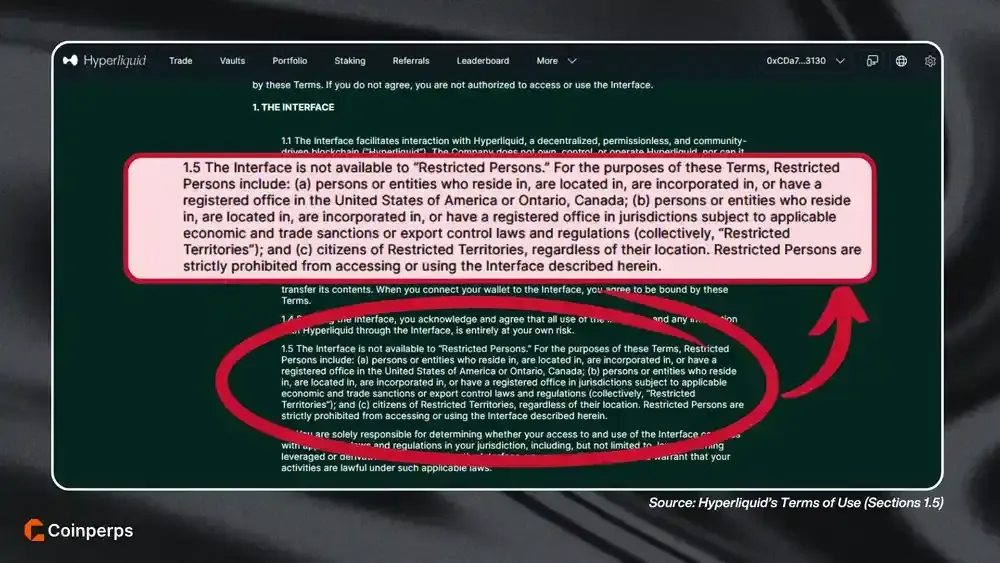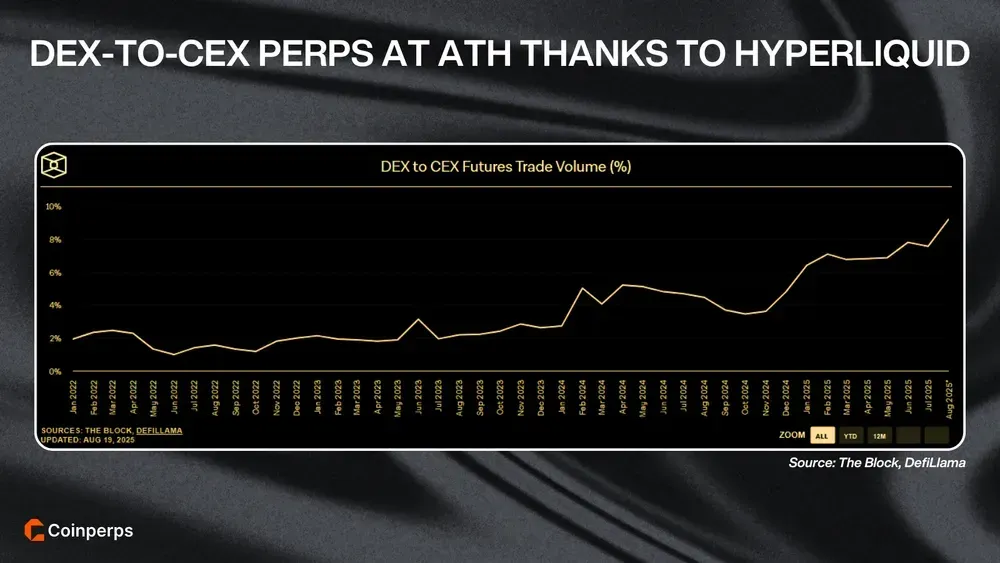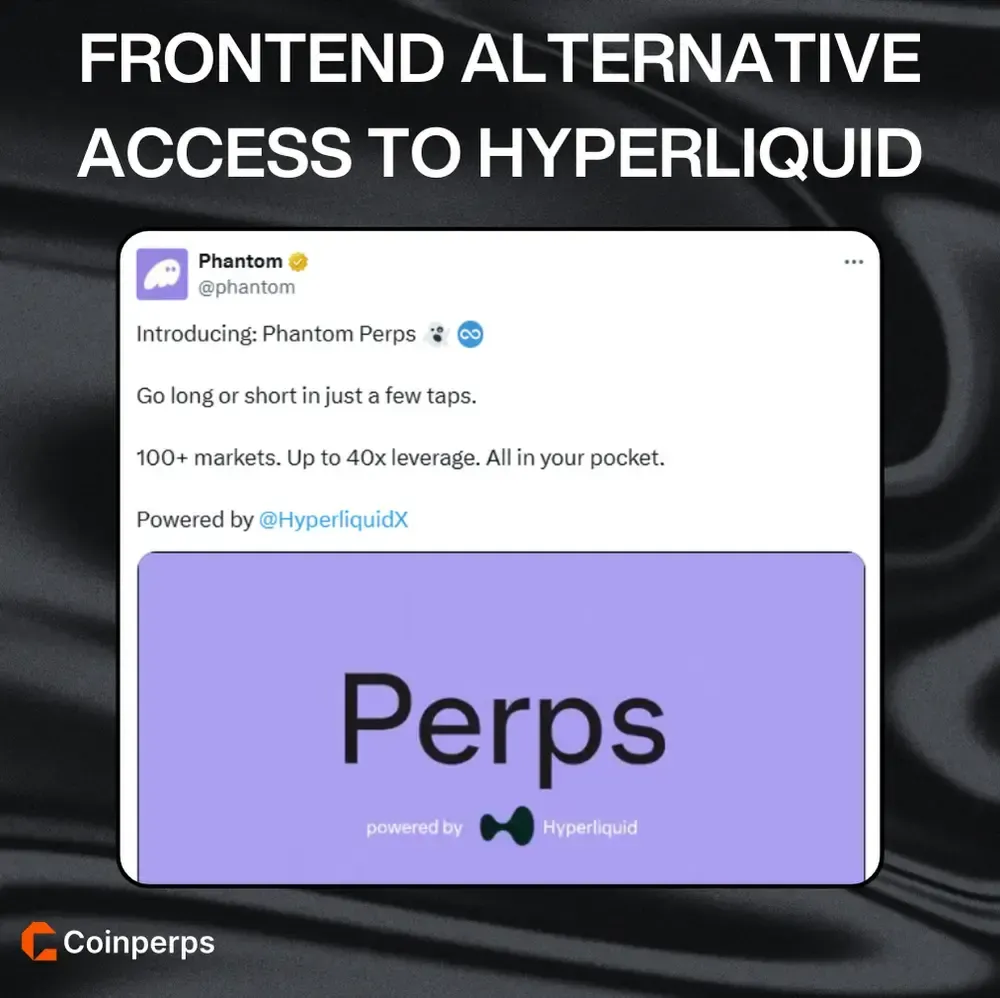- 24H Open Interest$134,992,232,369.31-1.58%
- 24h Liquidation$411,673,947.10%
- 24h long/short Ratio50.29% / 49.71%
- Fear & Greed Index41
- Bitcoin Price$92,968.5-0.77%
- Ethereum Price$3,267.731.72%
- Solana Price$140.252.1%
- XRP Price$2.29-2.69%
- 24H Open Interest$134,992,232,369.31-1.58%
- 24h Liquidation$411,673,947.10%
- 24h long/short Ratio50.29% / 49.71%
- Fear & Greed Index41
- Bitcoin Price$92,968.5-0.77%
- Ethereum Price$3,267.731.72%
- Solana Price$140.252.1%
- XRP Price$2.29-2.69%
Hyperliquid Restricted Countries List 2025 – Regions & Alternatives
Discover where Hyperliquid is restricted, what KYC rules apply, which countries are supported, and the top alternatives for perpetual futures trading in 2025.
Key Takeaways:
- Traders from the US, Ontario (Canada), and sanctioned regions cannot currently access Hyperliquid due to its Terms of Use restrictions.
- The good news is that everyone else across Europe, Asia, Latin America, and beyond can freely trade Hyperliquid's perps with up to 40x leverage and no KYC.
- If you fall into one of the unlucky restricted zones, alternatives across Euro-Asian centralized exchanges, North American platforms, and decentralized protocols have you covered.
Hyperliquid
Hyperliquid is the largest and most liquid decentralized perpetuals exchange, processing over $2 trillion in volume on a custom Layer-1 with sub-second finality.
Features
Fees
Regulation
Overall Rating
Hyperliquid is the most popular decentralized perpetual exchange, handling billions in daily trading volume and shaping on-chain derivatives. Its rapid rise has made it a key venue for traders seeking leverage without the mandatory KYC rules of centralized platforms.
This growth raises important questions: which countries permit Hyperliquid, where access is restricted, and what alternatives traders can use if blocked.
This guide details the restricted countries, explains Hyperliquid’s KYC policy, and highlights the strongest regulated and decentralized alternatives for 2025. ⬇️
List of Hyperliquid Restricted Countries in 2025
As stated in Sections 1.5 and 3.1.5 of Hyperliquid’s Terms of Use (updated January 26, 2025), the platform prohibits access from certain jurisdictions based on residency, citizenship, or sanctions-related restrictions.
Below is the list of currently restricted countries and regions:
- United States of America: Access prohibited for all residents, citizens, and incorporated entities, in accordance with U.S. federal regulations on digital asset trading.
- Canada (Ontario): Access prohibited for all residents, citizens, and incorporated entities, pursuant to provincial securities rules governing virtual asset platforms.
- North Korea: Access prohibited under UN and US sanctions targeting its financial networks, blocking cryptocurrency platforms to curb money laundering and nuclear financing.
- Iran: Blocked from Hyperliquid due to US and EU trade sanctions restricting capital flows, energy exports, and access to international banking systems.
- Cuba: Restricted in line with decades-old US embargo and international sanctions, which limit access to payment processors, remittances, and digital trading services.
- Syria: Excluded under global measures addressing terrorism financing and sanctions imposed during its civil war, restricting banking access and digital asset platforms.
- Crimea, Donetsk, and Luhansk: Users in these disputed Ukrainian regions are banned due to international sanctions linked to the ongoing conflict with Russia.
These restrictions cover anyone residing, located, incorporated, or registered in such territories, as well as citizens of those territories, regardless of their location.

Supported Countries and Currencies on Hyperliquid
Hyperliquid is accessible in most countries worldwide, excluding only those in its restricted jurisdictions. This includes key markets such as Singapore, Hong Kong, United Kingdom, Germany, Australia, Brazil, South Africa, and Japan, subject to compliance with local laws.
Hyperliquid provides trading access in the following regions:
- Asia-Pacific: Widespread access in jurisdictions including Singapore, Hong Kong, Australia, New Zealand, Japan, South Korea, and much of Southeast Asia.
- Europe: Support across the United Kingdom, Germany, France, the Netherlands, Nordic nations, Spain, Italy, and most other EU member states.
- Latin America: Availability in Brazil, Argentina, Chile, Colombia, Mexico, Peru, and additional countries with active and growing digital asset markets.
- Middle East & Africa: Access in South Africa, Nigeria, United Arab Emirates, Israel, Kenya, and several other permitted jurisdictions across both regions.
- Oceania & others: Coverage extends to island nations, overseas territories, and smaller states not subject to sanctions or local prohibitions.
As for supported currencies, all perpetual contracts use USDC as margin collateral and are quoted in USDT for stable settlement and universal pricing. Markets like PURR-USD and HYPE-USD use USDC-denominated oracles when the platform’s spot market has the deepest liquidity.

Does Hyperliquid Require Mandatory KYC Verification?
Hyperliquid does not impose mandatory Know Your Customer (KYC) verification for accessing its trading interface, allowing users to participate without identity checks. However, traders must still comply with the platform’s Terms of Use, which prohibit access from restricted jurisdictions.
In contrast, our research on Binance Futures restricted countries shows that centralized exchanges typically require full KYC verification (ID, proof-of-address, source of wealth) before allowing trading or deposits, making Hyperliquid a more accessible option for those who value privacy.
Is Hyperliquid Banned in the US?
Yes, Hyperliquid is officially unavailable to users in the United States, with its ToS prohibiting access for all residents, citizens, and incorporated entities. Nonetheless, our analysis of trading activity and tweeting patterns (e.g., active time zones) indicates that a major share of Hyperliquid whales are likely US-based.
Spotting this demand, Coinbase and Kraken launched perpetuals market after the CFTC’s spring 2025 review approved regulated offerings for US traders. Yet instead of cementing dominance, DEX-to-CEX futures volume climbed to a record 10.76% in mid-August, with Hyperliquid capturing 80% of that DEX share.

Can I use Hyperliquid with a VPN?
While it is technically possible to access Hyperliquid through a VPN, doing so to bypass geographic restrictions violates the platform’s Terms of Use (Section 3.1.5). The rules explicitly prohibit location masking technologies, and users caught circumventing restrictions risk account suspension or loss of access.
Trading on Hyperliquid If the Frontend Is Restricted
If Hyperliquid’s official frontend is unavailable in your region, traders sometimes seek alternative ways to interact with the protocol. The steps below outline general methods used to access decentralized platforms when the web interface is blocked, though availability and legality depend on your jurisdiction.
Possible access methods include:
- Use alternative frontends: Connect through community-operated or mirror sites that route trades to Hyperliquid smart contracts securely (High risk).
- Connect via trading APIs: Place and manage orders using API keys through reputable third-party platforms or trading software (Medium risk).
- Integrate with decentralized frontends: Access verified open-source interfaces hosted on IPFS or other decentralized hosting networks (Medium-low risk).
- Run a local instance: Host the official Hyperliquid frontend code locally to retain full control of your environment (Low risk).
- Interact through smart contract calls: Submit trades directly on-chain via explorers or CLI tools without relying on a frontend (Low/High risk).
One notable example of a supported alternative is Phantom Perps, which incorporates Hyperliquid’s liquidity directly into the Phantom wallet, enabling users in eligible regions to open, close, and manage perpetual futures positions without ever visiting the official Hyperliquid site.

Hyperliquid Hacking Incident Explained
In March 2025, Hyperliquid avoided a $12 million loss after an attacker exploited a liquidation flaw to pump JellyJelly by 429%. The manipulation put the $230 million Hyperliquid Liquidity Pool at risk, prompting validators to delist the token, freeze withdrawals, and settle at the attacker’s entry price.
The exploit enabled the attacker to withdraw $6.26 million before the freeze, and it exposed the protocol’s reliance on centralized intervention despite its decentralized branding. This raised concerns about risk controls, including large positions in illiquid assets and susceptibility to oracle manipulation.
In July 2025, Hyperliquid faced a separate, non-hack incident when a traffic spike caused a 37-minute API outage, sidelining traders from order execution. The platform reimbursed nearly $2 million to affected users, earning praise for its immediate response and partially rebuilding trader confidence.
Best Alternatives to Hyperliquid for Perpetual Trading
Choosing the right alternative to Hyperliquid depends on geography and regulation, with different options standing out in the US, Europe, Asia, and within decentralized markets. In the next section, we will look at two exchanges in each group that open the door to perpetual trading.
The table below compares the leading exchanges that traders often turn to as alternatives to Hyperliquid:
Alternatives to Hyperliquid in Europe
For traders in Europe, Hyperliquid’s perpetuals are appealing but the uncertainty around MiCA and CASP rules pushes some toward centralized exchanges as a preventative measure. In that context, two names dominate the Old Continent: Kraken for its regulatory clarity, and Binance for its scale and leverage.
Kraken has been around long enough to see multiple boom-and-bust cycles, yet it’s never been hacked, a rare badge of honor in crypto. Its new MiFID II–regulated derivatives desk finally gives Europeans a way to trade perpetuals inside a framework that institutions can actually touch, without sacrificing liquidity.
Binance takes the opposite tack: it thrives on size and speed, throwing up to 125x leverage and the deepest perp order books in the world at retail traders. Features like Credits Trading Mode show how it keeps reinventing its futures offerings in Europe, even as regulators keep circling.
Alternatives to Hyperliquid in the US
Despite recent regulatory greenlights for perpetuals, Hyperliquid remains technically unavailable to for traders in the US who don’t want to sacrifice privacy or anonymity. That has left space for compliant centralized exchanges to roll out perpetual products under the watchful eye of the CFTC.
Coinbase became the first mover in July 2025, introducing nano Bitcoin and Ether perpetual futures through Coinbase Financial Markets. With 10x leverage, five-year contract horizons, and low trading fees, it frames perpetuals as a retail-friendly product inside a fully regulated structure.
And once again, Kraken sits on the other side of the field, launching “Kraken Derivatives US” to unify CME-listed crypto futures with its liquid spot markets. The move extends Kraken’s push toward a multi-asset platform, offering crypto, tokenized equities, and traditional futures under one roof.
Alternatives to Hyperliquid in Asia
In the Far East, perps trading faces fewer regulatory hurdles, which means traders could freely use Hyperliquid, yet many still turn to centralized exchanges for the ease of fiat on- and off-ramps. Bybit and OKX sit at the heart of perpetual trading in Asia, offering both deep liquidity and high leverage.
Bybit consistently ranks as the second-largest venue for perpetual trading, trailing only Binance, and it matches the industry-max leverage of 125x. Its liquidity depth and streamlined derivatives platform make it attractive to both retail traders and professionals seeking tight spreads.
OKX, meanwhile, has cemented itself across Asian markets with competitive 125x leverage, wide fiat gateways, and strong regional presence. It has also pushed aggressively into DeFi integrations and Web3 products, making it more than a simple derivatives exchange.
Top Decentralized Alternatives to Hyperliquid
For now, Hyperliquid holds a near-monopoly over decentralized perpetual trading, but history shows monopolies in crypto can turn ugly. Nobody wants to end up in another Bitconnect-style collapse, which makes it worth exploring viable DeFi alternatives that keep competition alive.
Jupiter on Solana offers perpetuals with up to 150x leverage, though its 0.06% taker/maker fees are higher than Hyperliquid. It supports both long and short positions on majors like SOL, ETH, and wBTC, with flexible collateral management that pays profits in either stablecoins or the underlying tokens.
edgeX is the second-largest DeFi perps exchange by volume and the closest rival to Hyperliquid as of mid-2025. It settles trades back to Ethereum for security, while its engine processes 200,000 orders per second with sub-10ms latency, 100x leverage, and advanced tools like trailing stops.
Bottom Line
Hyperliquid is the most compelling DeFi venue for perpetuals right now, but access isn’t universal and the rules matter. If you can’t get in, regulated CEXs in Europe and the US or high-leverage Asian platforms like Bybit and OKX fill the gap, while Jupiter and edgeX keep DeFi’s competitive edge alive.
In the end, the question isn’t just where you’re allowed to trade, but which risks you’re willing to own.
Frequently asked questions
Fees depend on your rolling 14-day volume, with taker fees starting at 0.045% and maker rebates up to 0.015%. Higher tiers reduce costs, and top-volume traders can pay as little as 0.024% taker fees with zero maker fees.
The HLP vault performs market making and liquidations, distributing profits and losses to depositors. It is fully community-owned, and deposits are subject to a four-day lock-up period before withdrawals are available.
More than 100 perpetual assets are listed, with leverage ranging from 3x to 40x depending on the token. Maintenance margin is set at half of the initial margin at maximum leverage; for example, 2.5% at 20x.
Both deposits and withdrawals require signatures from two-thirds of validator stake to be finalized. Withdrawals carry a short dispute period and a 1 USDC gas fee, ensuring bridge security while covering validator costs.
.avif)